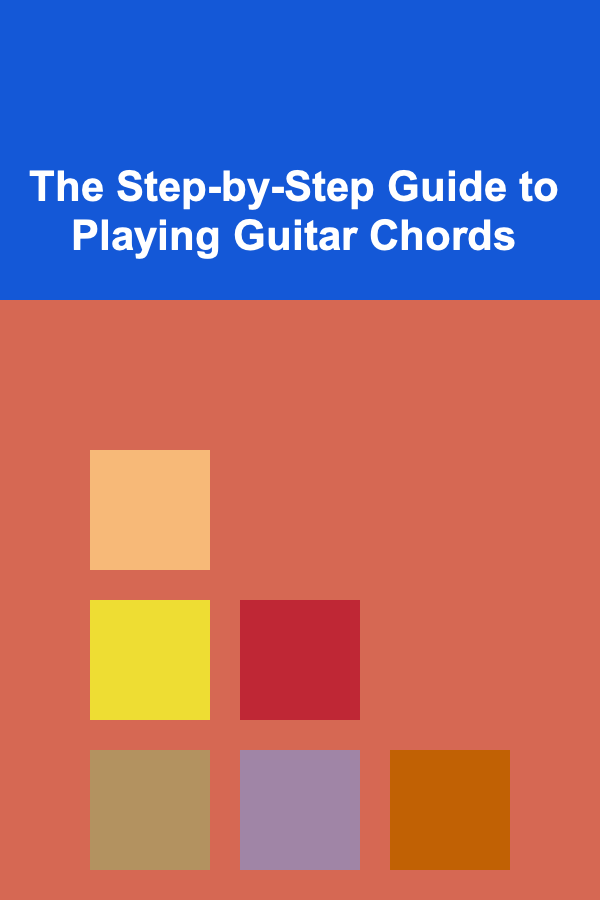
The Step-by-Step Guide to Playing Guitar Chords
ebook include PDF & Audio bundle (Micro Guide)
$12.99$10.99
Limited Time Offer! Order within the next:

Learning to play guitar can be one of the most rewarding musical endeavors, whether you're a beginner or an experienced musician looking to improve. One of the fundamental building blocks of guitar playing is learning how to play chords. Chords form the basis of most popular music genres, from rock and pop to folk and classical, and understanding how they work can unlock a world of musical creativity.
In this comprehensive guide, we'll walk you through the step-by-step process of learning to play guitar chords. By the end of this article, you'll not only know how to form basic chords, but also how to transition between them smoothly, play more advanced chord shapes, and apply your newfound skills to create music.
Understanding Guitar Chords
Before diving into the specifics of how to play chords, it's important to understand what they are. A chord is a group of notes played together at the same time. On the guitar, these notes are typically played on multiple strings, and the way you press the strings (the finger positioning) and strum or pluck the strings determines the chord.
There are several types of guitar chords:
- Major Chords: These chords have a bright, happy sound (e.g., C, G, D).
- Minor Chords: These chords have a sadder or darker tone (e.g., Am, Em, Dm).
- Seventh Chords: These chords add an extra note, creating a more complex, jazzy sound (e.g., G7, C7).
- Suspended Chords: These chords replace the third with another note, creating an open, unresolved feeling (e.g., Dsus4, Csus2).
Step 1: Learn the Basic Chord Shapes
To begin, you need to familiarize yourself with the most common chord shapes that every guitarist needs to know. These chords will be the foundation of many songs, and once you can play them comfortably, you'll have a solid grasp of basic chord progressions.
Open Major Chords
Open major chords are played using open strings (strings that are not pressed down). These chords are essential for beginners because they are relatively easy to play and are widely used in many genres of music.
-
C Major (C):
- Place your ring finger on the 3rd fret of the 5th string (A string).
- Place your middle finger on the 2nd fret of the 4th string (D string).
- Place your index finger on the 1st fret of the 2nd string (B string).
- Let the 3rd string (G string) ring open, and avoid playing the 6th string (low E string).
-
G Major (G):
- Place your middle finger on the 3rd fret of the 6th string (E string).
- Place your index finger on the 2nd fret of the 5th string (A string).
- Let the 4th string (D string), 3rd string (G string), and 2nd string (B string) ring open.
- Place your ring finger on the 3rd fret of the 2nd string (B string).
-
D Major (D):
- Place your index finger on the 2nd fret of the 3rd string (G string).
- Place your middle finger on the 2nd fret of the 1st string (high E string).
- Place your ring finger on the 3rd fret of the 2nd string (B string).
- Let the 4th and 5th strings (D and A strings) ring open, and avoid playing the 6th string.
Open Minor Chords
Minor chords have a more somber tone than major chords. Here's how to play the most common minor chords.
-
A Minor (Am):
- Place your index finger on the 1st fret of the 2nd string (B string).
- Place your middle finger on the 2nd fret of the 4th string (D string).
- Place your ring finger on the 2nd fret of the 3rd string (G string).
- Let the 5th string (A string) ring open and avoid playing the 6th string.
-
E Minor (Em):
- Place your middle finger on the 2nd fret of the 5th string (A string).
- Place your ring finger on the 2nd fret of the 4th string (D string).
- Let the 6th string (low E string), 3rd string (G string), 2nd string (B string), and 1st string (high E string) ring open.
-
D Minor (Dm):
- Place your index finger on the 1st fret of the 1st string (high E string).
- Place your middle finger on the 2nd fret of the 3rd string (G string).
- Place your ring finger on the 3rd fret of the 2nd string (B string).
- Let the 4th string (D string) ring open and avoid playing the 5th and 6th strings.
Step 2: Learn How to Read Chord Diagrams
Chord diagrams are visual representations of the guitar fretboard that show you where to place your fingers. These diagrams are incredibly helpful for beginners and will allow you to read chord shapes easily.
Here's an example of what a chord diagram looks like for the C major chord:
B|---1---|
G|---0---|
D|---2---|
A|---3---|
E|---X---|
- The vertical lines represent the guitar strings, with the leftmost line representing the low E string (6th string) and the rightmost line representing the high E string (1st string).
- The horizontal lines represent the frets. The numbers indicate which fret to press down on each string.
- An "X" means that you should not play that string.
- An "O" means the string should be played open (without pressing down any frets).
Step 3: Practice Switching Between Chords
Once you're comfortable with some basic chords, it's time to practice switching between them. The key to smooth transitions is muscle memory and finger strength, which will come with practice.
Start with simple chord progressions, such as:
- C - G - Am - F
- G - D - Em - C
Play each chord in the progression for four beats (or a similar rhythmic pattern), and focus on making clean transitions between each chord.
Tips for Smooth Transitions:
- Keep your fingers close to the fretboard and avoid lifting them too far away from the strings when switching.
- Practice slow and steady transitions before increasing your speed.
- Use a metronome to keep a steady rhythm and challenge yourself to stay in time as you switch chords.
- If you struggle with one particular transition, isolate it and practice that transition alone.
Step 4: Learn Strumming Patterns
Strumming is just as important as pressing the strings to form a chord. Strumming gives rhythm and texture to a song, and the right pattern can elevate your playing. Here are some basic strumming patterns to start with:
-
Down Strums Only:
- Strum all the strings in a downward motion, once per beat. This is the simplest strumming pattern.
-
Down-Up Strums:
- Strum downward on the downbeat and upward on the upbeat. This is a more dynamic pattern commonly used in pop and rock music.
-
Down-Down-Up-Up-Down-Up (DDUUDU):
- This is a common strumming pattern that's used in many songs. It combines both down and up strums in a catchy, rhythmic way.
As you practice these strumming patterns, try playing along with a song or backing track to maintain timing and rhythm.
Step 5: Explore Barre Chords
Once you've mastered open chords and basic strumming, it's time to explore barre chords. These chords involve pressing down multiple strings with one finger, creating a "bar" across the fretboard.
-
F Major Barre Chord:
- Place your index finger across all six strings at the 1st fret.
- Form an E major shape with the rest of your fingers (middle finger on the 2nd fret of the 3rd string, ring finger on the 3rd fret of the 5th string, and pinky on the 3rd fret of the 4th string).
-
B Minor Barre Chord:
- Place your index finger across all six strings at the 2nd fret.
- Form an Am minor shape with the rest of your fingers (middle finger on the 2nd fret of the 4th string, ring finger on the 4th fret of the 3rd string, and pinky on the 4th fret of the 2nd string).
Barre chords allow you to play chords all over the fretboard, which opens up new possibilities for chord progressions and songs.
Conclusion
Learning to play guitar chords is an essential skill for every guitarist. By starting with the basic major and minor chords, learning how to read chord diagrams, practicing smooth transitions, and mastering strumming patterns, you can build a strong foundation for playing guitar. As you progress, you can challenge yourself with more advanced techniques like barre chords and explore different musical genres.
Remember that practice and patience are key. Consistent practice will not only make you a more skilled guitarist but also deepen your understanding of music as a whole. Keep playing, stay motivated, and enjoy the journey!

How to Host a Successful Game Night Party at Home
Read More
How to Make Small Changes in Your Home to Save Big on Monthly Expenses
Read More
How to Start Saving for Retirement in Your 20s
Read More
Staying Positive: Developing a Winning Mindset for Job Search Success
Read More
Strategic Sustainability Leadership: A Practical Approach for Managers in the Era of Climate Change
Read More
How to Maintain Your Skydiving Rig
Read MoreOther Products

How to Host a Successful Game Night Party at Home
Read More
How to Make Small Changes in Your Home to Save Big on Monthly Expenses
Read More
How to Start Saving for Retirement in Your 20s
Read More
Staying Positive: Developing a Winning Mindset for Job Search Success
Read More
Strategic Sustainability Leadership: A Practical Approach for Managers in the Era of Climate Change
Read More